Simon Tarboush
THz-Band Near-Field RIS Channel Modeling for Linear Channel Estimation
May 14, 2025Abstract:Reconfigurable intelligent surface (RIS)-aided terahertz (THz)-band communications are promising enablers for future wireless networks. However, array densification at high frequencies introduces significant challenges in accurate channel modeling and estimation, particularly with THz-specific fading, mutual coupling (MC), spatial correlation, and near-field effects. In this work, we model THz outdoor small-scale fading channels using the mixture gamma (MG) distribution, considering absorption losses, spherical wave propagation, MC, and spatial correlation across large base stations and RISs. We derive the distribution of the cascaded RIS-aided channel and investigate linear channel estimation techniques, analyzing the impact of various channel parameters. Numerical results based on precise THz parameters reveal that accounting for spatial correlation, MC, and near-field modeling substantially enhances estimation accuracy, especially in ultra-massive arrays and short-range scenarios. These results underscore the importance of incorporating these effects for precise, physically consistent channel modeling.
Performance and Complexity Analysis of Terahertz-Band MIMO Detection
Apr 07, 2025Abstract:Achieving terabit-per-second (Tbps) data rates in terahertz (THz)-band communications requires bridging the complexity gap in baseband transceiver design. This work addresses the signal processing challenges associated with data detection in THz multiple-input multiple-output (MIMO) systems. We begin by analyzing the trade-offs between performance and complexity across various detection schemes and THz channel models, demonstrating significant complexity reduction by leveraging spatial parallelizability over subspaces of correlated THz MIMO channels. We derive accurate detection error probability bounds by accounting for THz-specific channel models and mismatches introduced by subspace decomposition. Building on this, we propose a subspace detector that integrates layer sorting, QR decomposition, and channel-matrix puncturing to balance performance loss and parallelizability. Furthermore, we introduce a channel-matrix reuse strategy for wideband THz MIMO detection. Simulations over accurate, ill-conditioned THz channels show that efficient parallelizability achieves multi-dB performance gains, while wideband reuse strategies offer computational savings with minimal performance degradation.
Mutual Coupling-Aware Channel Estimation and Beamforming for RIS-Assisted Communications
Oct 05, 2024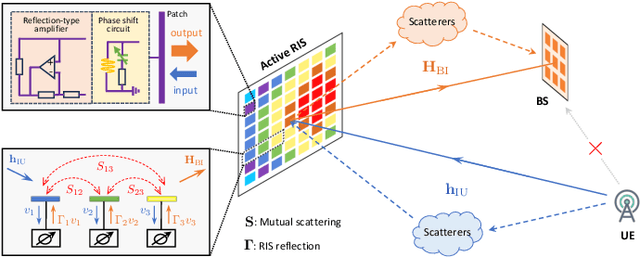
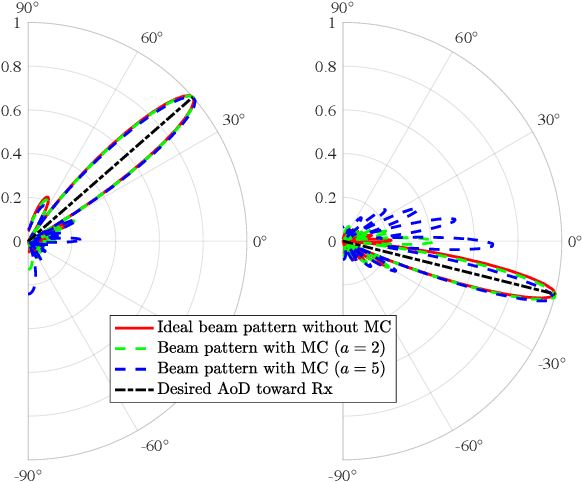
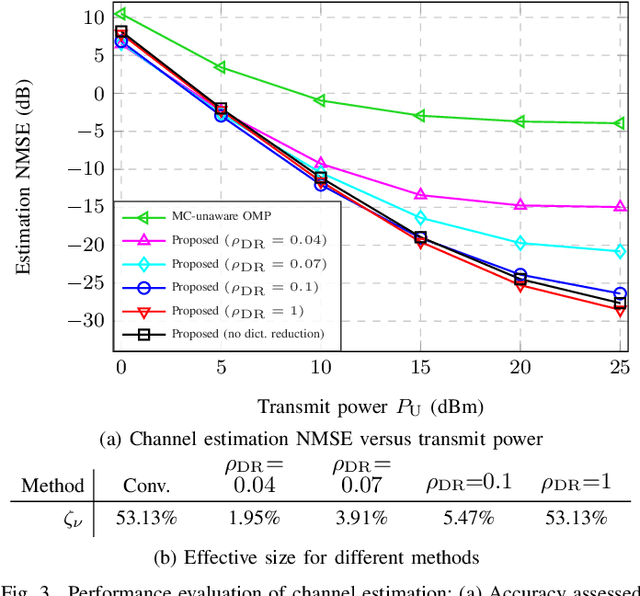
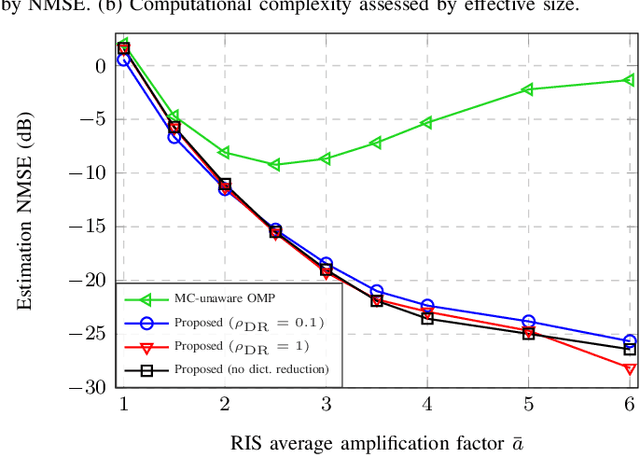
Abstract:This work studies the problems of channel estimation and beamforming for active reconfigurable intelligent surface~(RIS)-assisted communication, incorporating the mutual coupling~(MC) effect through an electromagnetically consistent model based on scattering parameters. We first demonstrate that MC can be incorporated into a compressed sensing~(CS) estimation formulation, albeit with an increase in the dimensionality of the sensing matrix. To overcome this increased complexity, we propose a two-stage strategy. Initially, a low-complexity MC-unaware CS estimation is performed to obtain a coarse channel estimate, which is then used to implement a dictionary reduction (DR) technique, effectively reducing the dimensionality of the sensing matrices. This method achieves low complexity comparable to the conventional MC-unaware approach while providing estimation accuracy close to that of the direct MC-aware CS method. We then consider the joint optimization of RIS configuration and base station (BS) combining in an uplink single-input multiple-output system. We employ an alternating optimization strategy where the BS combiner is derived in closed form for a given RIS configuration. The primary challenge lies in optimizing the RIS configuration, as the MC effect renders the problem non-convex and intractable. To address this, we propose a novel algorithm based on the successive convex approximation (SCA) and the Neumann series. Within the SCA framework, we propose a surrogate function that rigorously satisfies both convexity and equal-gradient conditions to update the iteration direction. Numerical results validate our proposal, demonstrating that the proposed channel estimation and beamforming methods effectively manage the MC in RIS, achieving higher spectral efficiency compared to state-of-the-art approaches.
Performance Analysis of Outdoor THz Links under Mixture Gamma Fading with Misalignment
Sep 01, 2024Abstract:The precision of link-level theoretical performance analysis for emerging wireless communication paradigms is critical. Recent studies have demonstrated the excellent fitting capabilities of the mixture gamma (MG) distribution in representing small-scale fading in outdoor terahertz (THz)-band scenarios. Our study establishes an in-depth performance analysis for outdoor point-to-point THz links under realistic configurations, incorporating MG small-scale fading combined with the misalignment effect. We derive closed-form expressions for the bit-error probability, outage probability, and ergodic capacity. Furthermore, we conduct an asymptotic analysis of these metrics at high signal-to-noise ratios and derive the necessary convergence conditions. Simulation results, leveraging precise measurement-based channel parameters in various configurations, closely align with the derived analytical equations.
Leveraging parallelizability and channel structure in THz-band, Tbps channel-code decoding
Sep 01, 2024Abstract:As advancements close the gap between current device capabilities and the requirements for terahertz (THz)-band communications, the demand for terabit-per-second (Tbps) circuits is on the rise. This paper addresses the challenge of achieving Tbps data rates in THz-band communications by focusing on the baseband computation bottleneck. We propose leveraging parallel processing and pseudo-soft information (PSI) across multicarrier THz channels for efficient channel code decoding. We map bits to transmission resources using shorter code-words to enhance parallelizability and reduce complexity. Additionally, we integrate channel state information into PSI to alleviate the processing overhead of soft decoding. Results demonstrate that PSI-aided decoding of 64-bit code-words halves the complexity of 128-bit hard decoding under comparable effective rates, while introducing a 4 dB gain at a $10^{-3}$ block error rate. The proposed scheme approximates soft decoding with significant complexity reduction at a graceful performance cost.
Near or far: On determining the appropriate channel estimation strategy in cross-field communication
Jun 09, 2024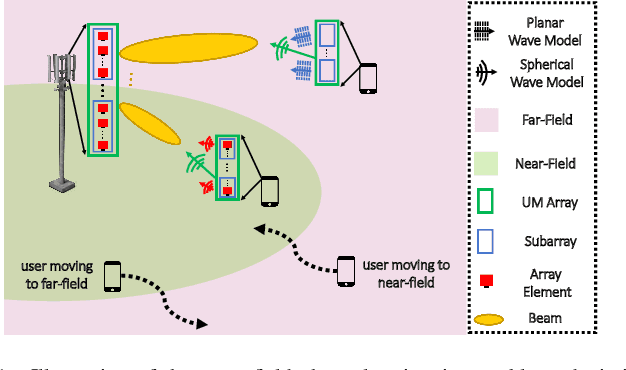
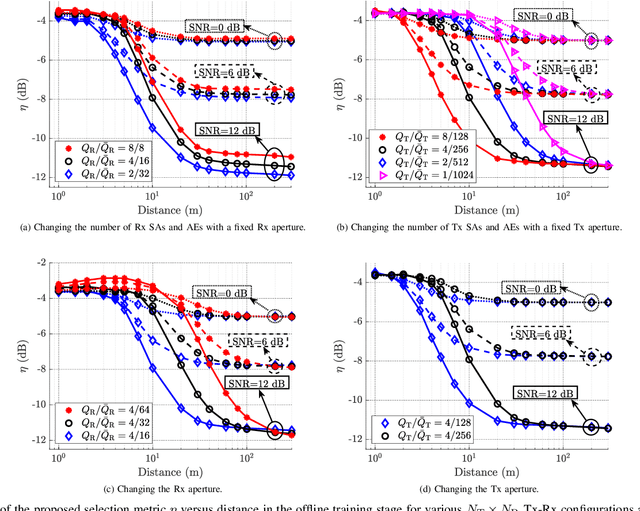
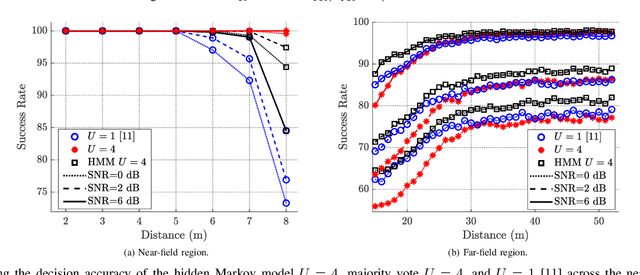
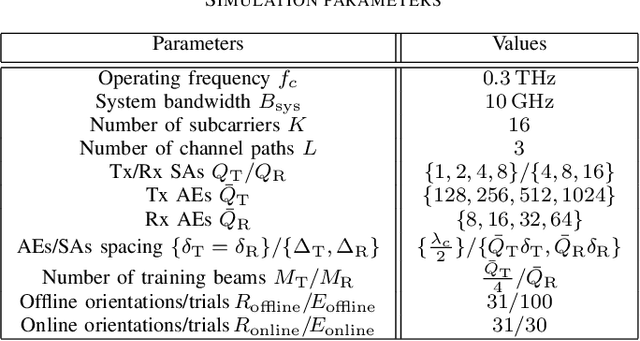
Abstract:The use of ultra-massive multiple-input multiple-output and high-frequency large bandwidth systems is likely in the next-generation wireless communication systems. In such systems, the user moves between near- and far-field regions, and consequently, the channel estimation will need to be carried out in the cross-field scenario. Channel estimation strategies have been proposed for both near- and far-fields, but in the cross-field problem, the first step is to determine whether the near- or far-field is applicable so that an appropriate channel estimation strategy can be employed. In this work, we propose using a hidden Markov model over an ensemble of region estimates to enhance the accuracy of selecting the actual region. The region indicators are calculated using the pair-wise power differences between received signals across the subarrays within an array-of-subarrays architecture. Numerical results show that the proposed method achieves a high success rate in determining the appropriate channel estimation strategy.
Bridging the complexity gap in Tbps-achieving THz-band baseband processing
Sep 27, 2023Abstract:Recent advances in electronic and photonic technologies have allowed efficient signal generation and transmission at terahertz (THz) frequencies. However, as the gap in THz-operating devices narrows, the demand for terabit-per-second (Tbps)-achieving circuits is increasing. Translating the available hundreds of gigahertz (GHz) of bandwidth into a Tbps data rate requires processing thousands of information bits per clock cycle at state-of-the-art clock frequencies of digital baseband processing circuitry of a few GHz. This paper addresses these constraints and emphasizes the importance of parallelization in signal processing, particularly for channel code decoding. By leveraging structured sub-spaces of THz channels, we propose mapping bits to transmission resources using shorter code words, extending parallelizability across all baseband processing blocks. THz channels exhibit quasi-deterministic frequency, time, and space structures that enable efficient parallel bit mapping at the source and provide pseudo-soft bit reliability information for efficient detection and decoding at the receiver.
Cross-Field Channel Estimation for Ultra Massive-MIMO THz Systems
May 23, 2023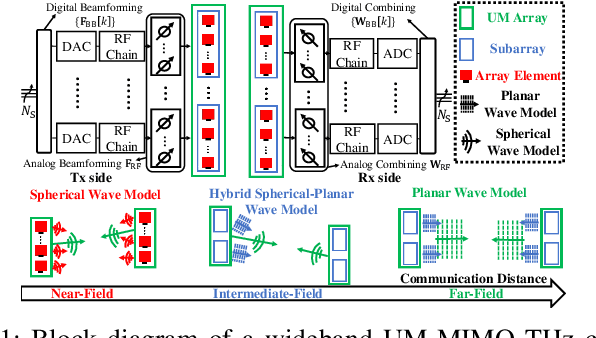
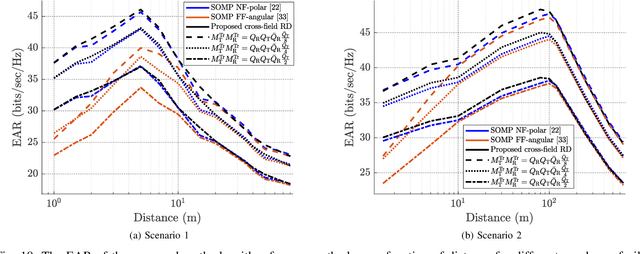
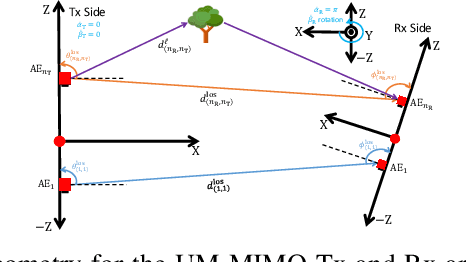
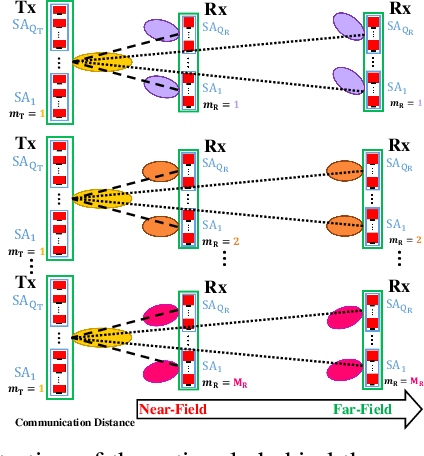
Abstract:The large bandwidth combined with ultra-massive multiple-input multiple-output (UM-MIMO) arrays enables terahertz (THz) systems to achieve terabits-per-second throughput. The THz systems are expected to operate in the near, intermediate, as well as the far-field. As such, channel estimation strategies suitable for the near, intermediate, or far-field have been introduced in the literature. In this work, we propose a cross-field, i.e., able to operate in near, intermediate, and far-field, compressive channel estimation strategy. For an array-of-subarrays (AoSA) architecture, the proposed method compares the received signals across the arrays to determine whether a near, intermediate, or far-field channel estimation approach will be appropriate. Subsequently, compressed estimation is performed in which the proximity of multiple subarrays (SAs) at the transmitter and receiver is exploited to reduce computational complexity and increase estimation accuracy. Numerical results show that the proposed method can enhance channel estimation accuracy and complexity at all distances of interest.
 Add to Chrome
Add to Chrome Add to Firefox
Add to Firefox Add to Edge
Add to Edge